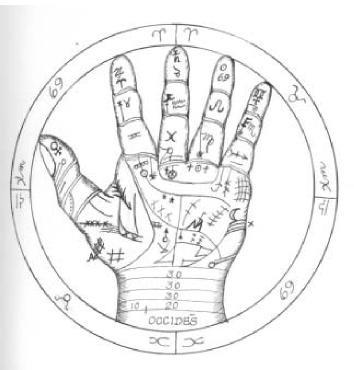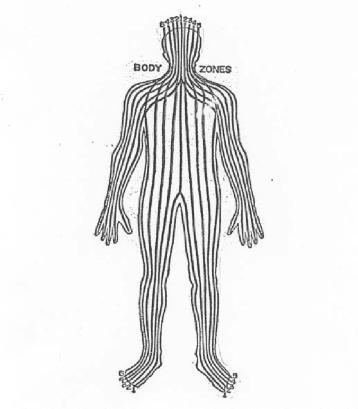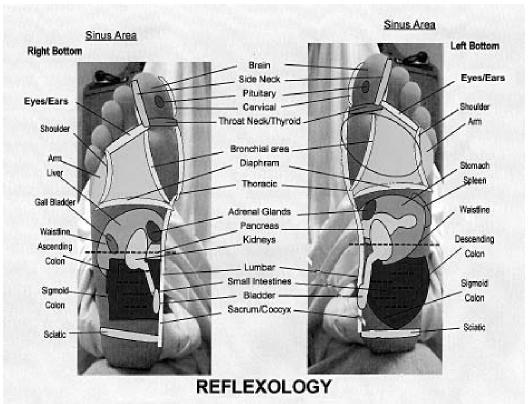Reflexology and Other
Energy-Balancing Therapies
From: Exposing Spiritualistic Practices in Healing
by Edwin A. Noyes M.D.
At the heart of alternative medicine therapies is the doctrine of correspondence, or sympathy, between the cosmos, earth, and man. This concept is central to the term life force energy. This energy in theory is emanating from the cosmos, from which all things are said to be made, and within which all are one (pantheism). 1) Levington, Richard, East-–West Journal of Natural Health and Living, The Holographic Body, Aug. (1988), Kushi foundation, Brookline, MA, p. 46. Let us look at some popular therapies for health disorders developed from this theory.
Early in the development of the astrological system in Europe, the 12 houses of the zodiac were assigned to various parts of the body starting at the head with Aries, the ram, and ending at the feet with Pisces, the fish. The organs of the body were then assigned to the remaining individual houses. 2) Bessy, Maurice, Magic and the Supernatural, Spring Books, NY, (1970), p.73. The Chinese divided the body in a vertical manner believing that a special universal cosmic energy they (referred to as chi) ran through the body following 12 vertical divisions called meridians. These meridians had side channels to distribute the energy to the various organs of the body. In contrast, the Hindus described the distribution of vital energy as being concentrated in seven centers in the body called chakras. The chakras utilized nadis (small channels) to distribute energy to the tissues surrounding each chakra. When the energies of the chakras were combined; an aura was believed to surround the individual.
As previously explained the cosmos was considered the macrocosm and man the microcosm. Man was then divided into micro-microcosms. Specific locations on the body were believed to have developed association in such a way as to represent the entire body. It was believed that cosmic energy influenced man by correspondence, association, and/or sympathy. 3) Levington, op cit., pp. 36–47.
One of the first body locations considered to reveal this sympathy, or correspondence, was the hand. It probably began in the Sumerian civilization. Birth omens were obtained by inspecting a newborn infant for any sign which would predict the child’s future. Palmistry likely had its origin in this manner. 4) Garrison, Fielding H. A.B., M.D.; History of Medicine, W.B. Saunders and Co. Philadelphia, PA. (1929), p. 63.
Palmistry, or Chiromancy, had roots in the ancient Vedas of India 4500 years ago. 5) Levington, op. cit., p. 38.

Figure 29. Palmistry and Zodiac
Additional areas of the body that were believed to have correspondence with all other areas of the body were added over time. Now, a total of 18 areas on the body are considered to be holograms of the whole. 6) Levington, op. cit., p. 43. The most common locations are ear, hand, foot, the web between thumb and forefinger, tongue, etc. Apart from the hologram locations, the musculature and fascia (membranes, tendons, ligaments) of the body are also believed to have many points that may impede the flow of universal energy so as to influence the function of body, mind, and spirit. Pressure, or some type of physical stimulation to those points, is said to affect—correct the flow of universal energy.
Why so many types of therapies if the treatments are effective? Because none of them are based on physical science but on the paranormal or psychic; the actual physical method used matters little in medical treatment. It depends on the mental attitude and acceptance of the theory of universal energy or cosmic intelligence.
Zone therapy—now called reflexology, Rolfing and similar massage, Shiatsu, Reike, craino-sacral therapy, polarity, and applied kinesiology, are techniques used by various holistic healers. These methods are collectively referred to as body therapy or soma therapy. Martial arts, tai chi, and qi gong are body or soma exercise-type treatments also providing Life Force Medicine.
Since it is believed that physical disease is a condition of unbalanced life force, universal energy, or chi, within the body due to congestion or blockage of flow, then correction of the imbalance would be achieved by manipulating points of correspondence. This is the foundation of acupuncture, acupressure, reflexology, and several other techniques collectively labeled soma (body) therapies.
REFLEXOLOGY
In 1913, an American doctor, William H. Fitzgerald M.D., initiated a method of applying pressure to localized areas on the body to affect anesthesia for performing ear, nose, throat, surgery. By 1923 it had been expanded to treat most all medical disorders and was very popular with self-appointed healers.

Figure 30. Zone Therapy
Doctor Fitzgerald was an admirer of, and influenced by Swedenborg, the famous Swedish spiritualists of the 1700’s. Fitzgerald believed in universal energy, or as it was called in those times vitalism. He was not the absolute originator of using pressure to areas on the body to effect healing; rather he borrowed this concept from the Chinese and Egyptians. An issue of EAST WEST Journal (March 1990), relates that a form of reflexology was in use in China during the earliest period of China’s history. In addition a hieroglyph depicting reflexology was found in a physician’s tomb in ancient Egypt. Fitzgerald “determined” from his own reasoning, that the body was divided into ten specific zones, five on each side (not substantiated by science), believing that each zone carried its own bioelectric energy which made direct connection to the brain. He applied pressure to specific points on the body, and then proceeded with operative procedures to the ear, nose, or throat area without the patient experiencing pain. Fitzgerald further theorized that such pressure would treat disorders of body organs that he had allocated to correlate with the ten zones.
Eunice D. Ingham, an American, took up this therapeutic approach (zone therapy) in the 1930’s, and carried it further, making it popular. She mapped out specific points on the feet and hands that she determined were sympathetic to specific organs. By rubbing those points on the hands or feet, beneficial effects or cures seemed to be accomplished. A lady in England, Doreen Baylay, called Fitzgerald’s and Ingham’s zone therapy, reflexology, and it is now very popular and practiced around the world.

Figure 31. Reflexology chart of foot.
Reflexology is the discipline of massaging the hand, foot, or ear to diagnose, predict future disease, and effect healing of present disease. It is founded upon belief in universal energy, vitalism, prana, chi, etc. Reflexology is also a variant of acupressure and/or Shiatzu, which are based on body correspondences and the meridian concept of Chinese Traditional Medicine. Reflexology has a similar philosophical background. 7) Levington, op. cit., pp. 36-47.
However the theoretical Western explanation of reflexology contends that there are nerve connections directly from the feet or hands to the brain connecting to various organs of the body. By rubbing a very specific point on a hand or foot, the nerve impulse is said to travel to the brain and is transferred on to a particular organ, thus correcting any abnormality of that organ. 8) Bergson, Anika; Tuchak, Vladimir, Zone Therapy, Pinnacle Books, Inc., New York, NY, (1974), p. 2.; Levington, op. cit., pp. 36-47. Reflexologists may or may not teach that there are crystals of calcium or uric acid and/or other substances on the nerve endings in the hands or feet. These crystals are supposed to have caused congestion of universal energy flow about and through nerves which are purported to connect directly with organs of the body. Massage is said to break up the crystals, which will relieve nerve or energy blockage, the nerve can then impart health to the area of affliction. 9) Levington, op. cit., pp. 40–41. No one has ever found these crystals by anatomical dissection or by any other method.
Reflexology purports the ability to diagnose, as well as to treat, by massaging either the hand, foot, or ear. Foot therapy in reflexology is the most common area for performing therapy, but hand treatment is supposed to be just as effective. Reflexologists proclaim that there are 7200 nerve endings on the bottom of a foot. I have never seen an anatomy or neurology book that said such, and even if it did, that does not mean the proclaimed point has specific connections to the various organs. There is no evidence that rubbing nerve endings would correct abnormal function of tissues elsewhere in the body.
If a person looks on the Internet for information relevant to reflexology there will be found 6.5 million web sites. It is a worldwide phenomenon. What disorders are claimed to be improved by use of reflexology? Some reflexologists speak only about relief from stress while others make no limits as to types of problems that can be treated and will be benefitted. Have there been any studies of scientific quality? There can be found on some web sites studies that claim to show benefit to many various medical disorders. Quality studies are another thing. It is very difficult to design a study for testing reflexology that uses randomly selected, double blind, placebo, and a control group.
William T. Jarvis, Ph.D. a prior professor at Loma Linda University taught research methods to aspiring scientists. He often challenges a new group of students to devise a study design to test reflexology. I will share with you some of the studies done using designs created from his classes.
Using questionnaires, 70 subjects were asked to record any health problems they had encountered on any of 43 anatomical locations in the past two years. A reflexologists then examined each of the individuals in a blinded manner. The feet were exposed but a sheet covered the individual and no voice contact was allowed. From this test the results of determining a diagnosis by reflexology were no better than guessing.
In another study, three practicing reflexologists examined 18 individuals that had at least one to six different conditions identified by physicians. The end results were that there was no correlation between the reflexologists’ findings and those identified by a physician.
A third study dealt with 35 women with premenstrual syndrome (PMS) which were randomly selected and assigned to either ear, hand, or foot reflexology, or a placebo group which had sham reflex points massaged. The women selected their personal symptoms from a list of 38 symptoms which are commonly associated with this syndrome. They then received reflex therapy. The results were that the treatment group had a modest reduction in symptoms compared to the placebo group. The placebo group complained that their treatment was rough and with discomfort. The group with improvement had thirty minutes of pleasurable relaxing treatment. This study suggested there may be some reduction of symptoms from PMS. There was no proof of a connection between reflex points and body organs.
A fourth study was done on patients with asthma, a disorder that is frequently claimed by many web sites to be benefitted by reflexology. Ten weeks of therapy was given to a treatment group and to a control placebo group. Lung function studies were conducted on both groups which did not change on either group. The conclusion was that no evidence of improvement beyond placebo was shown. 10) http://www.quackwatch.com posted Sept. 16, 1997. (Reflexology: A Close Look by Steven Barrett M.D.) accessed 3-30-11
Dr. Jarvis, in an article found on the Internet, shares with us his experience over several years as he did studies on reflexology. In the classes he conducted for post graduate studies in methods of research at Loma Linda University, he would bring a registered reflexologist to the class and have this individual present the theory and demonstrate the practice of reflexology. As previously mentioned he would challenge the students to design a method of testing the theory presented by the reflexologist. Eventually the reflexologist confided in Dr. Jarvis that even as he believed in reflexology he would like to see a study testing it.
Since reflexology claims to be able to prevent and to predict future disease, how do you test for that status? You cannot. Dr. Jarvis decided to test whether reflexologist could detect a present disorder of an individual and if the reflexologist failed that test then there would be no reason to try to design a test that determines whether or not future disease can be detected. The study that was done in response to the reflexologist’s request is the one reported above on the 70 people. At the conclusion of the study the reflexologists agreed that it was not possible to diagnose present problems by reflexology, thereby accepting the conclusion that reflexology would not be able to predict future disease or even to be therapeutic.
From that time on his practice would involve simple foot massages for people who wanted them with no diagnostic or therapeutic claims. 11) http://www.ncahf.org/articles/o-r/reflexology.html
A good foot rub is relaxing and without ill effects and no one should avoid such if they enjoy it. Just do not expect it to be diagnostic or correct health problems. Do not get caught up in such thinking, for if we do, we are then venturing into a system that is founded upon the doctrine of universal energy which leads us away from God’s system of health. The danger of accepting this type of therapy is that if people feel they have gained help in their personal discomforts from such a therapy, they begin to believe the philosophy by which the benefits are explained. This allows acceptance of the vital energy concepts and leads in to accepting Satan’s counterfeit health system, the “right arm” of his false message of salvation.
In a subset of reflexology, the ear is believed to represent the entire body by reflex. When the ear is used in therapy it is termed “auricular therapy.” In the East–West Journal of Natural Health and Living, Aug. 1988, p. 43, the claim is made that there are at least 18 known locations on the body, labeled holograms, wherein a specific point is claimed to influence a specific organ. The hand, the thumb, a tooth, the tongue, and many other areas are said to be micro-microcosms of man and of the cosmos.
An abstract from the Med J Aust. Sept 7, 2009: Is reflexology an effective intervention? A systematic review of randomized controlled trials.
OBJECTIVE:
To evaluate the evidence for and against the effectiveness of reflexology for treating any medical condition.
DATA SOURCES:
Six electronic data bases were searched from their inception to February 2009 to identify all relevant randomized controlled trials (RCTs). No language restrictions were applied.
STUDY SELECTION AND DATA:
Extraction: RCTs of reflexology delivered by trained reflexologists to patients with specific medical condition. Condition studied, study design and controls, primary outcome measures, follow-up, and main results were extracted.
DATA SYNTHESIS:
18 RCTs met all the inclusion criteria. The studies examined a range of conditions: anovulation, asthma, back pain, dementia, diabetes, cancer, foot oedema in pregnancy, headache, irritable bowel syndrome, menopause, multiple sclerosis, the postoperative state of premenstrual syndrome. There were 1 study for asthma, the postoperative state, cancer palliation and multiple sclerosis. Five RCTs yielded positive results. Methodological quality was evaluated using the Jadad scale. The methodological quality was often poor, and sample sizes were generally low. Most higher-quality trials did not generate positive finding.
CONCLUSION:
The best evidence available to date does not demonstrate convincingly that reflexology is an effective treatment for any medical condition. 12) http://www.ncbi.nlm.nih.gov/pubmed/19740047
Reflexology is practiced around the world. It is a sympathetic remedy based on the concept that man is the microcosm of the macrocosm (the cosmos). Again, reflexology can be considered a variant of acupressure or Shiatzu.
References
| ↑1 | Levington, Richard, East-–West Journal of Natural Health and Living, The Holographic Body, Aug. (1988), Kushi foundation, Brookline, MA, p. 46. |
|---|---|
| ↑2 | Bessy, Maurice, Magic and the Supernatural, Spring Books, NY, (1970), p.73. |
| ↑3 | Levington, op cit., pp. 36–47. |
| ↑4 | Garrison, Fielding H. A.B., M.D.; History of Medicine, W.B. Saunders and Co. Philadelphia, PA. (1929), p. 63. |
| ↑5 | Levington, op. cit., p. 38. |
| ↑6 | Levington, op. cit., p. 43. |
| ↑7 | Levington, op. cit., pp. 36-47. |
| ↑8 | Bergson, Anika; Tuchak, Vladimir, Zone Therapy, Pinnacle Books, Inc., New York, NY, (1974), p. 2.; Levington, op. cit., pp. 36-47. |
| ↑9 | Levington, op. cit., pp. 40–41. |
| ↑10 | http://www.quackwatch.com posted Sept. 16, 1997. (Reflexology: A Close Look by Steven Barrett M.D.) accessed 3-30-11 |
| ↑11 | http://www.ncahf.org/articles/o-r/reflexology.html |
| ↑12 | http://www.ncbi.nlm.nih.gov/pubmed/19740047 |
